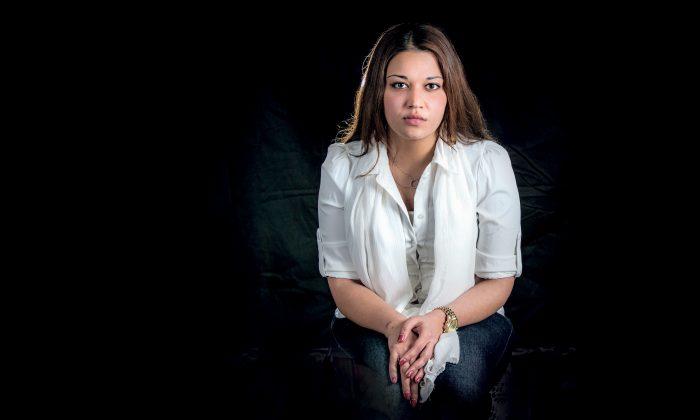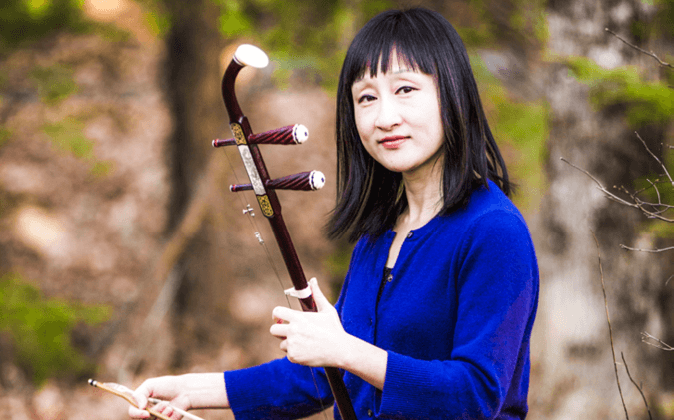NEW YORK—Naila Amin was an American teenager who wore pink velour suits and smoked cigarettes. She had a contagious, loud laugh, and envisioned herself as a police officer when she grew up. Fast forward four months, Naila found herself trapped as a 15-year-old wife in Pakistan. Ten days after her forced marriage, she rebelled by running for her life through the streets of Islamabad.
There were few females out on that January afternoon in 2005. Naila quickened her steps as she walked by men in huts, men on dusty buses, men in honking trucks, and men buying fruits and kebabs from street carts. Many of them eyed her suspiciously.
Naila was still donned in Pakistani nuptial attire—a red dress, and Henna-laden hands. It looked strange that she was not with her husband.
She thought she should check into a hotel so she could avoid bumping into familiar faces. But the manager refused to take her in without a man by her side.
So there she was, stranded in the capital. Running out of options and time, Naila considered getting into a taxi; two hours away from the city, in a remote village called Formulli, the men from all sides of her family were searching for her. Her father was at his house clutching his gun, armed and ready for an honor killing.
Naila’s decision to reject her marriage to her 28-year-old cousin brought dishonor to her family. As tradition goes, the disgrace needed to be paid for with her life.
Yet Naila could not bring herself to get into the taxi. She would have to tell the driver she was going to the U.S. Embassy. And that was a very dangerous thing for a girl to say in Pakistan.
In a Taliban-occupied country where Americans were frequently kidnapped for ransom, a situation that occurred so often that the U.S. Department of State issued a travel warning, Naila feared she would not make it to the embassy by herself.
Wrapped in a stranger’s shawl purchased from a poor woman in her village, Naila blended in with the myriad of shoppers at a large supermarket. There, she called a trusted uncle.
The trusted uncle answered, picked her up, but drove her right back to her husband’s house.
Numbed by fear and rage, Naila silently prepared to die.
A Perplexing Issue for Advocates
Forced child marriages happen to American citizens like Naila more often than is known.
Forced marriages and betrothals are prevalent for American girls as young as 4 years old, and on average 14 to 25 years old.
From 2009 to 2011, at least 3,000 forced marriages occurred to girls and young women from 47 states in the United States, and many involved girls under the age of 18. This data was from a survey conducted by the Tahirih Justice Center, an NGO that provides pro bono legal services for abused immigrant women and girls in the United States.
“We regularly get calls from people under 18,” said Heather Heiman, Tahirih’s Forced Marriage Initiative Project manager. “Our survey was just scratching the surface.”
The Forced Marriage Initiative Project was founded in 2011 as a response to the onslaught of forced marriage calls the center had been receiving over the last decade.
While much attention and resources are directed toward overseas child marriages, for years advocates did not know how to grapple with the issue of forced marriages in the United States.
Forced marriages are a culturally sensitive and complex issue that most government agencies—like women’s shelters, Child Protective Services (CPS), the U.S. State Department, U.S. consulates, and local law enforcement agencies—are not quite equipped to handle due to a lack of awareness of the issue in the United States.
In many cases, CPS would not classify an impending forced marriage to a minor as abuse. The department cannot do anything until after abuse occurs.
“We’ve seen widely different responses. Some people from Child Protective Services don’t think it falls under the category of abuse and neglect,” Heiman said. “They don’t see it as abuse until it happens.”
But after a forced marriage happens to an American girl overseas, it’s too late to do anything because the U.S. government cannot intervene in a marriage deemed legal in another country.
Minors who are looking to run away from forced marriage situations have fewer options than adults. Most women’s shelters do not take in people under the age of 18. For those that do, legal guardians or CPS are called after 24 hours.
Around 67 percent of the girls and young women surveyed by the Tahirih Justice Center said their issues weren’t identified as problems by local agencies.
“An agency’s inability to identify forced marriage cases may be attributable, at least in part, to their lack of awareness of and attention to this issue,” The Tahirih Justice Center wrote in its report. “Less than 10 percent worked for agencies that had a working definition of forced marriage.”
Yet, the stakes can be high.
After a 20-year-old Iraqi-American named Noor Almaleki backed out of an arranged marriage in Arizona, her father struck her with his car and killed her in 2009.

A Lone Bastion
The Tahirih Justice Center creates individualized escape plans for girls in forced marriage situations in the U.S.
It arranges a safe mode of transportation, as well as a plan for dealing with the family’s responses by contacting the police proactively.
For girls in immediate danger of a forced marriage, the organization communicates with local service providers and explains the nuances of the situation so victims can find temporary shelter in the U.S.
Perhaps most important, it provides emotional support for girls after they make the decision to leave.
Young girls, sometimes very young girls, have to choose between everything they know and love—mothers and fathers, sisters and best friends, homes and schools—and a solitary new life where they have the freedom to choose when and whom to marry.
American Child Bride
While many of these marriages occur when girls are sent back to their native countries, not all happen that way. Many forced marriages happen on American soil.
In New York and most other states, girls as young as 16 are legally allowed to get married if there is parental consent. In some states, the age minimum is even lower. In Massachusetts a girl can be as young as 12; in California there are no age limits if there is parental consent. Yet the consent of the child is ignored.
Other times, a private religious ceremony is conducted at home.
“They'll do an Islamic marriage or another kind of marriage,” said Naheed Bahram, a program director for Women for Afghan Women, an NGO based in the United States that finds shelter for forced marriage victims. “It happens everywhere in the U.S.”
Although the marriage is not legal, it’s considered finalized by the family and the community.
Why Forced Marriages Happen
Girls and young women are forced into marriages for reasons such as security, companionship, and the preservation of a family’s reputation.
Sometimes it’s a way of stopping behaviors that the family disapproves of, like dating outside of one’s culture or religion.
Yet oftentimes, when forced marriages are in the works, the signs are not visible to outsiders.
For many years, there was no indication of trouble in the Naila household.
Naila had a normal immigrant childhood in many aspects. When she was 4 years old, her family moved from Pakistan to Queens in pursuit of a better education for their children.
Her father owned a gas station, sometimes working 18 hours a day so the family could buy a house on Long Island.
It was the American Dream that began to go askew when Naila went back to Pakistan for a visit at age 8. During that trip, her father’s brother claimed Naila for his 21-year-old son.

His son wanted to be a doctor in the United States. Marrying an American would facilitate his immigration process.
It didn’t seem like a big deal at first, to be engaged at 8 years old. It was a normal occurrence in her family. Naila’s mother married at age 14.
Naila’s family is Pashtun, an ethnic group with populations in Pakistan and Afghanistan. It is part of their culture for girls to get engaged and married while they are still children.
The issue, however, is not limited to the Pashtun culture.
In the United States forced marriages occur to girls and young women from various ethnic and religious backgrounds—most frequently Pakistani, Afghan, Indian, and Somalian. The religions vary from Muslim to Orthodox Jewish to no religious affiliation. The Tahirih survey found it happened to females from 56 different countries of origin.
An engagement at 8 and a marriage at 15 may sound young, but perhaps only young by Western standards, and the Tahirih Justice Center is mindful of that. The center only helps girls and women who have chosen to reject a marriage by reaching out to advocates.
It’s not to say that arranged marriages are bad. Arranged marriages can turn into healthy relationships if there is mutual consent. But forced—particularly forced early marriages—tend to lead to domestic violence, early pregnancies, and higher risks of maternal mortality.
The Nikah
During a trip to Pakistan at age 13, Naila’s family held a religious wedding ceremony called a “Nikah” for her and her fiancé.
But she did not consider herself married to her cousin, a stern, thin man who was 6 feet 2 inches tall.
After the “Nikah,” Naila returned to New York and carried on with her normal teenage life.
She met a boy with braided hair during her freshmen year in high school. He complimented her pink outfit on her birthday and she found him charming. He asked her to be his girlfriend on Christmas Eve, and they fell in love.
A neighbor caught him sneaking into her house and told her father.
Her father was incensed and beat her until there were bruises. Despite her wounds, Naila shouted back at her parents that she did not accept her “Nikah,” and that she wanted to marry her boyfriend. This caused her father to beat her harder and her mother to bite her.
A social worker at school noticed Naila’s purple marks and called CPS. Naila was put into foster care.
The Marriage Trap
At her foster care group home, Naila looked forward to Saturdays the most. Saturday was family visitation day. Her mother would bring a week’s worth of home-cooked Halal food. She'd always make her favorite: Keema, a ground beef dish with pita bread.
“No one can love you like your mom, there’s no place like home,” Naila said.“ I didn’t want this marriage, but I loved my culture and my family.”

Not long after, Naila decided to run away from foster care and secretly returned to her family.
She stopped going to school at age 14 and lived secretly at home. CPS workers would make surprise visits at their house every week to check if she was there and Naila would hide in the closet during these inspections.
Finally, her family decided it was best for them to live in Pakistan until Naila turned 18.
Little did Naila know, a formal wedding was awaiting her in Pakistan.
The Return to Her Husband’s House
When Naila’s uncle drove her back to her husband’s house after she ran away, she begged her uncle to call U.S. Child Protective Services if anything happened to her upon her return.
He promised her that everything would be all right. Her family had locked her father in his house and they expected him to calm down in a few days.
Then, they saw her cousin in the village. He was carrying a gun. He got into the car and gave her a harsh, backhanded slap.
Once they arrived at her husband’s home, her uncle’s confidence in the situation deteriorated.
Instead of gratitude, her husband coldly accused her uncle of eloping with Naila. This reaction offended her uncle, who in turn alerted Child Protective Services of Naila’s whereabouts.

But the U.S. government could not intervene in a marriage recognized as legal in another country.
There was nothing that Child Protective Services could do for Naila when her husband punished her that night.
In front of her in-laws and her mother, he dragged Naila by her long, black hair, from one side of the house to the other, and then from the other side back, and then back again, not stopping even though her mother screamed for mercy.
He went on to kick her in the head. He kicked her so hard that she began to lose her vision and see stars and flashes of light.
Later that night, he raped Naila in her pink marble bed, as he would do so on many nights in the months to come.
Throughout their marriage, she would make two more failed attempts to escape. But the beatings worsened after each run.
He pummeled and thrashed her on a regular basis, making her nose bleed and leaving choke marks on her neck.
But the torment was mental as well, for he was a psychologist.
He'd make her lie, undressed on the cold, cement floor, and tell her, “It’s your body but you have no control over it. I rule you,” Naila recalled.
With her passport and cellphone locked away by her husband, Naila gave up and acquiesced to a life of captivity.
She dreaded sunsets. It represented the arrival of night, the time when she would have to sleep with him.
“It was unbearable,” Naila said. “I cooked for my enemy, cleaned for my enemy, slept next to my enemy.”
She would stare at his hunting rifle on the wall and thought about killing him. But she did not have it in her to kill.
Once, she swallowed bleach. But the taste was too pungent for her to drink enough to die.
Another time, she held a fruit knife in her hand and thought of ending her life. But she could not muster the will to stab.
“I just couldn’t go out like this, not like this,” she said. “I have so much to offer to this world. I have always felt that way, even as a little girl.”
Against All Odds
During the fifth month of Naila’s marriage, her parents returned to the United States.
Upon their return, her mother was arrested on charges of kidnapping. She had taken Naila out of the country when she was no longer considered her legal guardian.
Her father had no choice but to ask her husband to allow her to return to the United States.
Naila almost couldn’t believe it when she received the call.
During the ride to the airport, her husband grabbed her and warned her that she was not allowed to sleep at anyone else’s house during her stay in the United States. But she didn’t mind.
“I’m never going to see you again!” she recalled thinking.
Upon landing at the JFK Airport in New York, the pilot announced that no one could leave their seats until Naila was found.
A team of 20 officers—social workers, Child Protective Services, and airport police—waited for Naila.
Naila was taken to the Nassau University Medical Center’s psyche ward, where doctors ran tests on her mental and physical health.
She awoke the next morning to a ray of sunlight on her face, her body tucked in hospital sheets that reeked from unknown chemicals and stains.
But it was one of the happiest morning of her life, the first morning she woke up without him.
Finding Solace
Ten years later, Naila stares out the window from her childhood living room, the same living room where she and her parents had fought over her high school boyfriend.
She moved back into her parents’ home after she turned 18 and has since then, for the most part, reconciled with her mother and father.

Naila, 25, is still going to therapy every two weeks to help her make sense of her pain.
Some scars never go away, like a dent on her upper left thigh that appeared after her ex-husband’s repeated kicks.
She currently suffers from post-traumatic stress disorder (PTSD). She has anxiety attacks—and little things, like driving past a wedding ceremony during the day, can trigger flashbacks.
Up until a year ago, she found herself screaming at her mother during unguarded moments.
“Why? Why did you put me through that?” she recalled yelling.
This past St. Patrick’s day marked the 10-year anniversary for Naila’s return to the United States, and the end of her forced marriage. And it was the first year that she did not remember the anniversary.
She said therapy helped her make a breakthrough in January, when she spoke to her ex-husband on the phone for the first time since she left.
“I said hello. It got quiet. Then he said softly, hello, [pause] Naila?” Naila recalled.
He spoke to her robotically at first, throwing around cliches like “let bygones be bygones.”
She was determined not to have her heart drop from fear at the sound of his voice.
“Then I asked him to forgive me for breaking his heart,” she said. “If he approached me in a softer manner maybe I would have eventually learned to love him. But he handled it very badly.”
She told him she was studying psychology at school. He said that was nice.
Their two-minute conversation gave her the closure she had been missing for 10 years.
“He took a part of my soul that I'll never get back,” she said. “But I forgive him. I have to forgive before I can let go. You give that person power when you don’t forgive.”
In January, her parents moved back to Pakistan, where her father built a hospital for the poor. He asked her to go back and see his hospital. Naila was reluctant at first, but plans to visit after she graduates from Nassau Community College at the end of the year.
“My parents have said they’re sorry and I’ve accepted it,” Naila said. “I hope everyone’s story can end with a happy ending like mine, but many end with mental illness, it ends with depression, it ends with death.”
As for the next phase of her life, she plans on attending Molloy College to get her bachelor’s and master’s in social work, while specializing in forced marriages.
“Before addressing the worldwide issue, we need to address it here in the States,” Naila said.

She finds solace in the thought that perhaps there was a reason for her suffering. Perhaps she had to go through it so that she could gain the strength and wisdom to help young girls in forced marriage situations in the United States.
After she receives her master’s, Naila plans on starting a special group home for South Asian girls that will allow them to follow their religion and diet after they leave home.
“I remember them looking for a Muslim home through all of New York and not finding one,” Naila said.
She recalled how the foster care system did not know what to do with Naila, who stayed in a total of four foster homes and seven group homes. “No one was culturally competent enough to help me,” she said.
In some ways, Naila has already achieved the most rewarding results.
After witnessing Naila’s suffering and the havoc that it wreaked, her family will not make her youngest sister or nieces go through forced marriages.

Naila turned and looked deeply into the face of her 8-year-old niece, Ameera Rehman, who is the same age that Naila was when she got engaged.
“Aren’t you glad I went through what I went through so you don’t have to?” she asked her niece.
Adorned in a pink head band and a One Direction watch (themed after the popular pop boy band), Ameera is not entirely aware of what a forced marriage pertains to.“Yes!” she answered sweetly.





